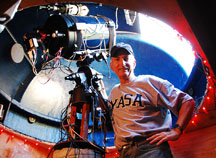The Hayabusa Spacecraft Re-Entry
Mission to Australia - June 2010
Image Chronology from
Australia Expedition
March 2011 Hypersonics Workshop Poster Paper Material from Nolthenius
Image of Final Poster Paper Presented at Hypersonics Workshop
The Hayabusa
spacecraft is finishing its long mission to study asteroids - and
it calls for some Indiana Jones style astronomy by a uniquely suited team which
includes yours truely. Seven years ago, the Japanese Space Agency launched the
Hayabusa spacecraft, which visited the asteroid Ikotawa
and returned photos of by far the most bizarre asteroid we've yet encountered.
Understanding the formation and evolution of asteroids is not only of scientific
interest, but is critical for decisions in asteroid collision mitigation. Until
now, the only material we've directly returned from space from another body,
is from the moon. Hayabusa is returning to Earth with the first samples from
an asteroid - a very strange one - and unprocessed by the blistering heating
which happens when meteorite falls happen. The spacecraft will re-enter the
Earth's atmosphere over Australia in mid June, and its re-entry needs to be
carefully recorded. First, to insure proper recovery as rapidly as possible.
And too, the heat shield performance needs to be carefully studied in-flight,
and the physics of ablation of material at hypersonic speeds in the Earth's
atmosphere needs characterization in carefully calibrated situations. Yes, we've
seen plenty of meterorite falls - but we don't know the size and shape of such
objects BEFORE they enter the atmosphere. It is the Hayabusa re-entry, and missions
such as the Stardust and ATV re-entry missions of '07 and '08, which are providing
the carefully calibrated opportunities to study ablation and shock wave formation
involving known materials of known physical parameters. The Hayabusa re-entry velocity will be uniquely fast - similar to that of future Mars missions and also similar to meteorite entries. Only the second flight test of a thermal protection system under such conditions, following the Stardust SRC entry in January of 2006
For this reason, it is especially
important to get data on the earliest moments of re-entry. While several ground
teams will be monitoring the re-entry, they will mostly be situated to support
the recovery effort down range. Our team, uniquely, will be positioned to gather
spectrophotometry data early in re-entry while the spacecraft is in the upper
atmosphere. Our location cannot be made public at this time, but it is remote,
and the mission will not be easy. Good physical condition and the ability to
deal with unexpected situations far from help will be required in order for
mission success.
Our Team
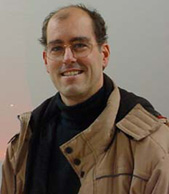 The mission's Chief Scientist is Dr.
Peter Jenniskens of NASA Ames and the SETI Institute. He is an
expert in the physics
of meteors and asteroid material science. Peter is coordinating
the science goals of our special ground team, which include astrometry and spectrophotometry.
During the Hayabusa re-entry, he will be aboard the NASA aircraft recording
the event.
The mission's Chief Scientist is Dr.
Peter Jenniskens of NASA Ames and the SETI Institute. He is an
expert in the physics
of meteors and asteroid material science. Peter is coordinating
the science goals of our special ground team, which include astrometry and spectrophotometry.
During the Hayabusa re-entry, he will be aboard the NASA aircraft recording
the event.
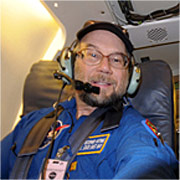 Professor
Christopher Kitting
- California
State University East Bay. Chris' interest range widely, from being
one of the world's experts in invertebrate biology, to astrophotography, to issues in global warming
mitigation. But it is his expertise in imaging and video recording in extreme
environments, and his previous experience with NASA re-entry missions, which
uniquely qualifies him for this mission. He is a veteran of NASA and the European
Space Agency's Automated Transfer Vehicle 1 Re-entry mission in 2008. Because
of his prior experience on a NASA mission he's designated leader while we're
on the ground in Australia. Chris is also pretty tough - former California State Collegiate Champion in water
skiing, XC skier, and fresh from a filming session wrestling the Giant
Squid of the Gulf of California for National Geographic TV in April '10. Chris
will be using a short focal length refractor and grating to record low resolution
spectra, as well as associated imaging using HD video and cameras.
Professor
Christopher Kitting
- California
State University East Bay. Chris' interest range widely, from being
one of the world's experts in invertebrate biology, to astrophotography, to issues in global warming
mitigation. But it is his expertise in imaging and video recording in extreme
environments, and his previous experience with NASA re-entry missions, which
uniquely qualifies him for this mission. He is a veteran of NASA and the European
Space Agency's Automated Transfer Vehicle 1 Re-entry mission in 2008. Because
of his prior experience on a NASA mission he's designated leader while we're
on the ground in Australia. Chris is also pretty tough - former California State Collegiate Champion in water
skiing, XC skier, and fresh from a filming session wrestling the Giant
Squid of the Gulf of California for National Geographic TV in April '10. Chris
will be using a short focal length refractor and grating to record low resolution
spectra, as well as associated imaging using HD video and cameras.
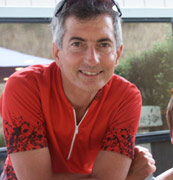 Dr.
Richard Nolthenius
- Cabrillo College. Rick's expertise in astrophotography and in asteroid and
lunar grazing occultation photometry at remote locations using low-light video
and GPS time-stamping equipment, and in leading group expeditions to remote
locations, led to his selection for this mission. He has a long record of being
able to "MacGuyver" equipment together in remote spots and get the
data under pressure of time and tough conditions. Rick's also no stranger to
demanding physical situations, a
veteran triathlete of 25 years, and fresh from the St. George Ironman
Triathlon on May 1 this year. His part in the mission will be two-fold. First
- obtaining high resolution spectrophotometry during re-entry using an objective
transmission grating. This requires accurate angular offset manual tracking
and insuring that sensitive equipment works in the Outback's winter conditions.
Second - as the astronomer of the team, he will be responsible for updating
and hardcopy'ing accurate star charts of the re-entry path across the sky to
insure acquisition and recording of the spacecraft from the moment it enters
the Earth's atmosphere. The space craft will be given mid-course corrections
right up until the time the team has arrived at their remote location, so that
pre-printed charts will not be adequate. He will also train all team members
in understanding the motions of the sky and navigate their way around the stars to insure accurate pointing of their equipment, taking into account the limiting magnitudes, angular fields of view, and spectrophotometry required offsets. He's developed a unique and robust technique for offset guiding suited for objective lens grating systems using inexpensive equipment and the stars.
Dr.
Richard Nolthenius
- Cabrillo College. Rick's expertise in astrophotography and in asteroid and
lunar grazing occultation photometry at remote locations using low-light video
and GPS time-stamping equipment, and in leading group expeditions to remote
locations, led to his selection for this mission. He has a long record of being
able to "MacGuyver" equipment together in remote spots and get the
data under pressure of time and tough conditions. Rick's also no stranger to
demanding physical situations, a
veteran triathlete of 25 years, and fresh from the St. George Ironman
Triathlon on May 1 this year. His part in the mission will be two-fold. First
- obtaining high resolution spectrophotometry during re-entry using an objective
transmission grating. This requires accurate angular offset manual tracking
and insuring that sensitive equipment works in the Outback's winter conditions.
Second - as the astronomer of the team, he will be responsible for updating
and hardcopy'ing accurate star charts of the re-entry path across the sky to
insure acquisition and recording of the spacecraft from the moment it enters
the Earth's atmosphere. The space craft will be given mid-course corrections
right up until the time the team has arrived at their remote location, so that
pre-printed charts will not be adequate. He will also train all team members
in understanding the motions of the sky and navigate their way around the stars to insure accurate pointing of their equipment, taking into account the limiting magnitudes, angular fields of view, and spectrophotometry required offsets. He's developed a unique and robust technique for offset guiding suited for objective lens grating systems using inexpensive equipment and the stars.
 Dr.
Julie Bellerose
- Carnegie Mellon University and NASA Ames. Julie is a professional astrodynamicist
and has experience in tracking and field data acquisition. Her experience is
in astrodynamics and NASA's Small Solar System Body Exploration division, including
mission analysis, orbit determination and perturbation methods, small body dynamics
combined with surface science and interior composition studies, spacecraft applications
and mission operations. She's also a competitive cyclist, veteran of the Florida
Ironman triathlon and in excellent physical condition. Julie will be using an
image intensifier to record the debris trail with the goal of supporting recovery
trajectory calculations for fragments and characterization of the shock front
induced spacecraft breakup.
Dr.
Julie Bellerose
- Carnegie Mellon University and NASA Ames. Julie is a professional astrodynamicist
and has experience in tracking and field data acquisition. Her experience is
in astrodynamics and NASA's Small Solar System Body Exploration division, including
mission analysis, orbit determination and perturbation methods, small body dynamics
combined with surface science and interior composition studies, spacecraft applications
and mission operations. She's also a competitive cyclist, veteran of the Florida
Ironman triathlon and in excellent physical condition. Julie will be using an
image intensifier to record the debris trail with the goal of supporting recovery
trajectory calculations for fragments and characterization of the shock front
induced spacecraft breakup.
May 15 - Calibration at SETI
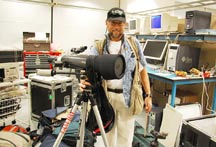
Chris, w/ short focal length
refractor
|
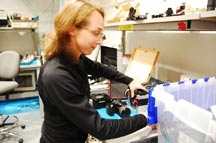
Julie adjusting the battery pack
for the image intensifier
|
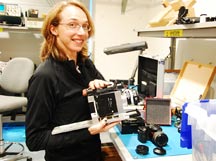
Rigged, and ready
|
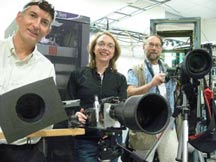
Optics at the ready...
|
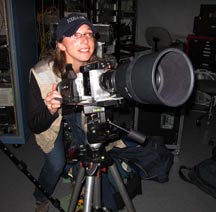
Julie adopts her Action
Pose
|
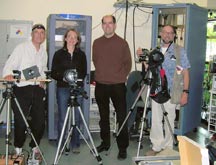
Our NASA/SETI Ground Team
|
May 22 - Calibrations at
SETI: Continuum Source
The goal here was to use our final
configuration instruments to record an accurately calibrated continuum spectrum
source comparable in brightness to the Hayabusa spacecraft at maximum predicted
re-entry temperature. This requires accurate distance to the source, for comparison
with the spacecraft later to get absolute fluxes.
|
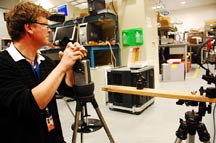
Mike lasers the distance
from the continuum source to the grating on my rig
|
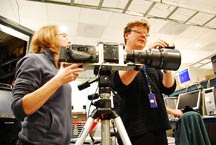
And for Julie
too. |
|
June 4: Julia
Cheung, of the Santa Cruz "Good Times" Weekly, interviewed me at Cabrillo
Observatory for a nice article in the June 17 issue, linked here.
June 5,6 - More Practice
and Calibration Sessions at Cabrillo College
Goal here was for me to practice
tracking on aircraft, insure that the stellar pairs I'd identified gave accurate
angular offsets for spectral line positioning, and to determine the limiting
magnitude of continuum sources in order to narrow my star pair choices on re-entry
night final alignments. I started out at the top of Horticulture Hill where
I planned to use high pressure sodium emission line (sodium D line blend) to
verify angle offset. But I rapidly found that the sea of sodium street lights
of Capitola and Aptos gave a kalidescope of emission lines which could not be
one-to-one associated with any particular street light. At the observatory below,
there was no such problem. I dialed in Venus, could see the O I line at 777
nm at the right place, and then placed my red LED light across the way and saw
the red line at 626nm.at the right spot. Then to Arcturus, which turned out
be in/out of fog by now, but gave a barely visible continuum (K star, with good
intensity in the near IR). With better focus and a darker sky, I might be able
to record a spectrum down to 1st magnitude - good enough for positioning and
for Hayabusa. All this was with the 50mm f/1.8 Nikon lens.
June 7 - Flight to Australia
for the mission: See my Australia photo page
Post Script - March 2011
This mission has had plenty of challenges, beginning with the unexpected solar storm which knocked out some of the solar panels on Hayabusa early in the trip to the asteroid Ikotawa and forced difficult decisions in trying to accomplish the principal goal of returning asteroid samples to Earth. These challenges continued even after the difficult re-entry campaign. The Workshop on Hypersonics at Brisbane, Australia provided the opportunity to coordinate and share scientific results of the mission. But in January, Brisbane was hit with the worst flooding in Australia's history, with an area the size of France and Germany combined, underwater. Chris and I felt sure the workshop would be delayed, but it was not. Then just 3 weeks later, Brisbane was hit with the strongest hurricane in Australia's history. We felt sure the workshop would be called off. But it was not. Finally, just a week before the workshop start, Japan was hit with the strongest earthquake in the history of Japan, a devastating tsunami, and multiple nuclear reactor meltdowns and radiation evacuations. The tsunami warnings included Brisbane, and many of the JAXA Haybusa mission scientists lived in and around Sendai, Japan, which was the worst hit of the earthquake/tsunami devastated areas. They survived. Yet we felt sure NOW the workshop would surely be cancelled. It was not. This is a tough bunch of people, and I and the rest of our ground team are honored to be part of this crew. Our poster presentation of our results from Tarcoola is here, with (readable) hi-res version due when formal publication is settled.
 The mission's Chief Scientist is Dr.
Peter Jenniskens of NASA Ames and the SETI Institute. He is an
expert in the physics
of meteors and asteroid material science. Peter is coordinating
the science goals of our special ground team, which include astrometry and spectrophotometry.
During the Hayabusa re-entry, he will be aboard the NASA aircraft recording
the event.
The mission's Chief Scientist is Dr.
Peter Jenniskens of NASA Ames and the SETI Institute. He is an
expert in the physics
of meteors and asteroid material science. Peter is coordinating
the science goals of our special ground team, which include astrometry and spectrophotometry.
During the Hayabusa re-entry, he will be aboard the NASA aircraft recording
the event. Professor
Christopher Kitting
Professor
Christopher Kitting Dr.
Richard Nolthenius
Dr.
Richard Nolthenius Dr.
Julie Bellerose
Dr.
Julie Bellerose








